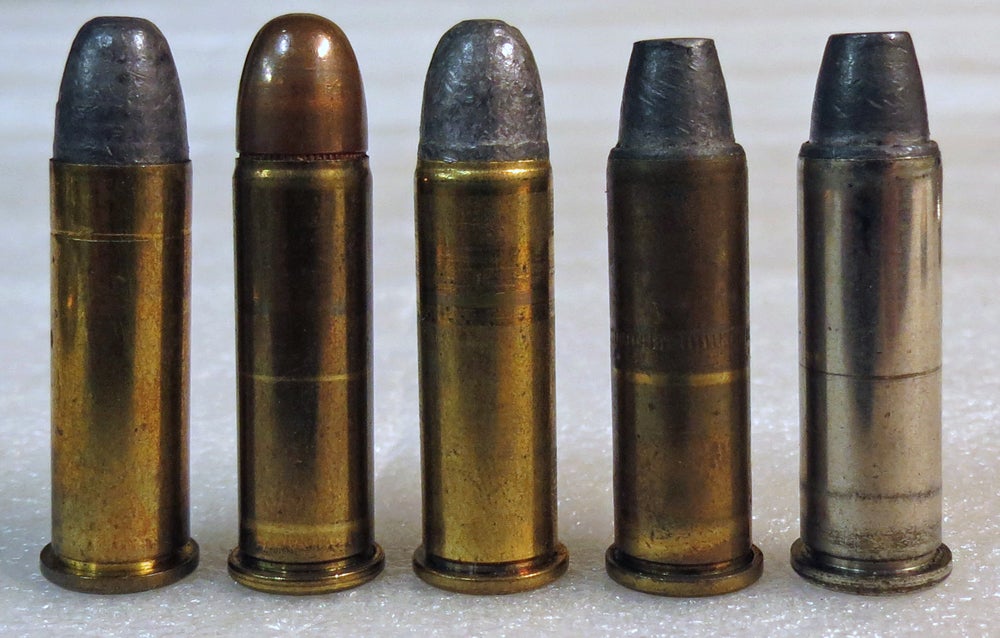Profile of a Cartridge: History and Development of the 38 Special
Russ Chastain 08.28.13

Back in 1902 when the 38 Smith & Wesson Special cartridge was introduced, no one could have predicted what the future held for it. Almost certainly, no one would have guessed that after more than 110 years the 38 Special would be the centerfire handgun cartridge with the highest number of factory loadings available, but that’s how it panned out. There was a certain round that came along in the 1930s and gave it a great boost (we’ll get to that later), but the 38 Special stands on its own in many ways.
One reason for this lack of life expectancy would likely have been the 38 Special’s humble beginnings. Although conceived as a more powerful alternative to the rather pathetic 38 Long Colt round, the 38 Special began life with only marginally-increased oomph. This was 1902, after all, and the use of smokeless powder was still in its infancy; early 38 Special ammo was in fact loaded with black powder (about 21 grains of it). The original bullet was a 158-grain round nose unjacketed variety, and only attained perhaps 800 fps in velocity.
The early 1900s was a very active period in firearm and cartridge development, and experimentation led to improvements. A change from black powder to smokeless produced a marginal improvement in velocity (as well as producing much less corrosive residue when fired), and in 1909 a Colt-inspired version, then called the 38 Colt Special, introduced a flat-nosed bullet that greatly increased the stopping power even at such modest velocity.
What’s in a Name?
Nowadays, we are accustomed to seeing many different bullet types and load variations for any given cartridge name, but that was not the case early on; the original cartridge with the pointed round-nose bullet was the 38 Smith & Wesson Special, the flat nose version of 1909 was the 38 Colt Special, another variation was named the 38/44, and others simply had the words “high velocity” attached. There was even a “38 Special Super Police,” which used a blunt, heavy 200-grain bullet moving at a mere 650 fps average muzzle velocity.
Over the years, things kind of settled down and now all compatible ammo is called 38 Special, although many variations of bullet weights and styles are available, loaded to many different power levels.
As loads improved and things worked themselves out, the 38 Special showed itself to be a very good cartridge. It is controllable enough to be fired comfortably by weaker shooters, may be fired rapidly with more consistent accuracy by most, and is inherently accurate.
All of this might have been moot and the 38 Special long faded from memory by now, if it hadn’t been for the well-known and much-loved 357 Magnum, which was introduced in 1935. The developers of the 357 mag had the good sense to simply lengthen the 38 Special’s case when they developed that round, making the millions of guns since chambered for 357 Magnum perfect candidates for shooting the 38 Special.
Shooting 38s in a 357
When all other things are equal, the choice between a revolver chambered for 357 Magnum or 38 Special is a no-brainer: choose the 357. The reason is that you can then shoot either flavor of groceries in your popper. For target shooting, I prefer the lower recoil, greater affordability, and consistent accuracy of the 38 Special, and in fact I rarely burn 357 Magnum ammunition at the range. Clearly, this has been a major factor in the longevity of the 38 Special cartridge.
Better than 9mm
When you hear someone low-rating the 38 Special, you are hearing the voice of ignorance. It is now and has long been a good cartridge, and with the proper ammo it makes a fine self-defense round. You will also encounter those who sneer at the 38 Special while they cuddle and pet their 9mm pistols; these people are to be pitied and ignored. The fact is – as I heard my father say many times – the 9mm is almost as good as the 38 Special. The 9mm fires a slightly smaller-diameter bullet which is almost always lighter than the average 38 Special bullet, and its short case means the 9mm has embarrassingly low powder capacity. The 38 Special in a revolver can also be dependable with flat-nose bullets, which isn’t true of the 9mm’s most common platform, the semi-automatic pistol – and flat nose bullets hit harder than round nose bullets.
The 38 Special is first and foremost a revolver cartridge, but it has been successfully used in derringers, semi-automatic pistols, and repeating rifles (notably lever-actions). While most often seen in double action wheel guns, it is found in single action revolvers as well.
The 38 Special is an absolute success story, and there’s a much wider variety of ammunition and guns available for it now than 80 or 100 years ago. It’s been likened to the 30-06 in terms of longevity and its being a benchmark; while rifle cartridges are measured against the yardstick of the 30-06, handgun cartridges have long been compared with the 38 Special.